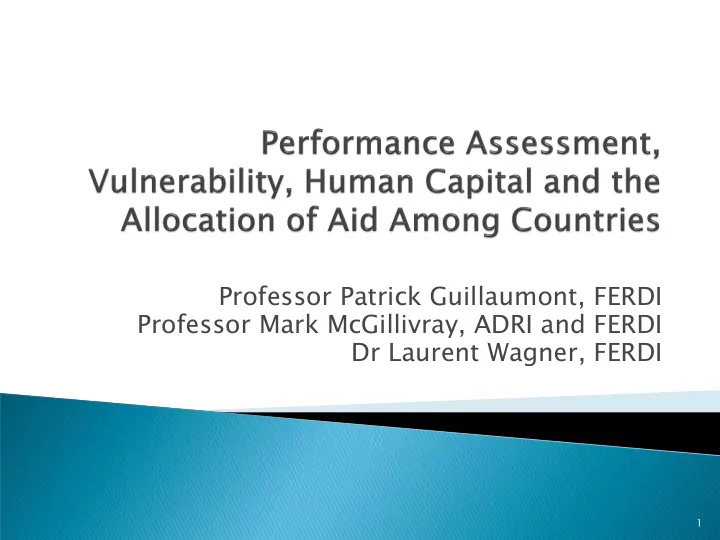

Professor Patrick Guillaumont, FERDI Professor Mark McGillivray, ADRI and FERDI Dr Laurent Wagner, FERDI 1
Critique Performance Based Allocation Models Focus on the IDA allocation model Question the design of these models ◦ Performance is defined too simply Ignores initial conditions Discriminates against low human capital pro-reform countries ◦ Reductionist with respect to aid efficiency Ignores other pre-conditionals for effective aid Provide simple statistical evidence in support of these criticisms Provides grounds for augmentation of performance based allocation models 2
0.125 GNI A CPR P 5 i i i i P i where A i is IDA aid, CPR i is country performance rating, GNI i is gross national income and P i is population, each for recipient country i . CPR i is defined as: CPR 0.24 CPIA 0.68 CPIA 0.08 PP ABC D i i i i where CPIA i ABC is the mean of components A to C of the CPIA, CPIA i D is component D of the CPIA and PP i portfolio performance, each for country i . 3
Rewards performance ◦ ex post conditionality and providing incentives for countries to reform More reform, more aid Efficient ◦ Broadly consistent with Collier-Dollar poverty efficiency Maximises poverty reduction among countries eligible for IDA support by giving preference to countries in which aid is thought to be more effective, those with better policies and institutional performance Equitable Systematic Imposes discipline on an otherwise chaotic process 4
Performance is defined too simply ◦ Takes no account of initial conditions, human capital in particular ◦ Penalises pro-reform countries that do not have the ability to reform, making a bad situation worse ◦ Counter to providing incentive for economic reform Reductionist with respect to efficiency ◦ Aid effectiveness is also a function of other variables Structural economic vulnerability (Guillaumont and Chauvet, 2001, Chauvet and Guillaumont, 2004) 5
Do the data back up these criticims? ◦ Are CPIA and CPR scores negatively related with economic vulnerability, the latter measured by the EVI? ◦ Are CPIA and CPR scores positively associated with human capital, the latter measured by the HAI (or negatively associated with low human capital)? (Note: such a correlation is a necessary but not sufficient condition for validation of the first criticism outlined above) We evaluate these questions using cross section data for 2007 and pooled data for 1975 to 2005 6
Scatter Plot of CPIA and EVI, 1975-2005 4,50 4,00 3,50 3,00 C 2,50 P I 2,00 y = -0,04x + 2,9433 A R² = 0,0055 1,50 1,00 0,50 0,00 2,00 3,00 4,00 5,00 6,00 7,00 8,00 9,00 EVI 7
Scatter Plot of CPIA and HAI, 1975-2005 4,50 4,00 3,50 3,00 C 2,50 P I 2,00 y = 0,0757x + 2,5356 A 1,50 R² = 0,0636 1,00 0,50 0,00 0,00 1,00 2,00 3,00 4,00 5,00 6,00 7,00 8,00 9,00 10,00 HAI HAI 8
Estimates from 2007 and pooled data of five year averages from 1975 to 2000 for up to 110 countries (n=466) 110 Countries IDA Countries IDA Countries OLS, 2007 Panel RE, 1975-2000 Panel RE, 1975-2005 -0.23 -0.27 -0.15 EVI coefficients (0.06)*** (0.04)*** (0.08)** 0.14 0.04 0.04 HAI coefficients (0.05)*** (0.05) (0.05) Robust standard errors in parentheses. The dependent variable is the CPIA and regressors also include GNI per capita, regional and time dummy variables. All continuous variables are in logarithms. * significant at 10%. ** significant at 5%. *** significant at 1%. The impact of EVI on the CPIA is strong and statistically significant in every regression Evidence for HAI is evident from the regression using 2007 data 9
Estimates from quartile regressions using pooled data of five years average from 1975 to 2000 for 110 countries (n=466) Quartiles Q25 Q50 Q75 -0.29 -0.17 -0.15 EVI coefficients (0.04)*** (0.03)*** (0.03)*** 0.09 0.05 0.05 HAI coefficients (0.05)** (0.05) (0.05) Bootstapped standard errors in parentheses. Regressions have the CPIA as the dependent also include as regressors GNI per capita and regional and time dummy variables. All continuous variables are in logarithms. * significant at 10%. ** significant at 5%. *** significant at 1%. The impacts of EVI and HAI on the CPIA are stronger at lower levels of the CPIA 10
Estimates from quartile regressions containing EVI shock and EVI exposure variables and using pooled data from 1975 to 2005 Quartiles Q25 Q50 Q75 EVI “Shock” -0.12 -0.08 -0.04 (0.04)*** (0.03)*** (0.02)* components EVI “Exposure” -0.19 -0.12 -0.13 (0.04)*** (0.03)*** (0.04)*** components 0.10 0.04 0.02 HAI (0.05)** (0.04) (0.02) Bootstrapped standard errors in parentheses. The regression has the CPIA as dependent variable and also includes GNI per capita and regional and time dummy variables as regressors. All continuous variables are logarithms. * significant at 10%. ** significant at 5%. *** significant at 1%. The impact of past shocks is stronger for lower CPIA levels … … while the EVI Exposure coefficients remain stable across quartiles. 11
Performance in IDA and similar allocation models is poorly defined Negatively associated with economic vulnerability Negatively associated with human capital A strong case exits for augmenting IDA and similar allocation models with economic vulnerability and human capital measures 12
Patrick Guillaumont, FERDI Mark McGillivray, ADRI and FERDI Laurent Wagner, FERDI 13
Recommend
More recommend